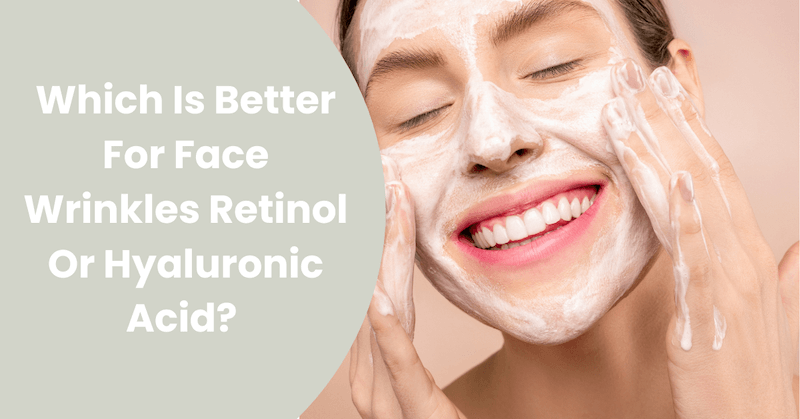Do you want to find the best product to incorporate into your skincare routine, to reduce the appearance of fine lines and wrinkles? Both retinol and hyaluronic acid have great benefits – but also have different results on the skin.
Hyaluronic acid is a humectant that increases moisture in a dehydrated skin, reduces the appearance of fine lines and wrinkles and may repair the skin from sun damage. Retinol increases cell production, unclogs pores, increases collagen production and smoothens the skin. Retinol may have long-term effects on reducing fine lines and wrinkles. Retinol and hyaluronic acid work well together – but certain skincare ingredients should be used cautiously like retinols and acids. Hyaluronic acid as a serum should be used before retinol and retinol should only be used at night time. The best acids used to reduce the appearance of fine lines and wrinkles could be ferulic acid, galactose, hyaluronic acid and ascorbic acid (vitamin C). However, each skin has different needs.
In order to address whether retinol or hyaluronic acid is better for reducing wrinkles, we’ll talk about benefits, application, which products to combine and which acids work best in reducing wrinkles.
Is Hyaluronic Acid Better For Your Skin Than Retinol?
When it comes to skincare products, you may be wondering which has the best effect on your skin – and also what the benefits are from both hyaluronic acid (HA) and retinol.
Hyaluronic acid is a sugar molecule also called polysaccharides or GAG found in the body’s connective, epithelial and neural tissues. HA binds up to 1000 times its weight in water and lubricates the skin.
The main purpose of hyaluronic acid is to increase hydration in the skin. If the skin is dehydrated it appears dry and rough on the surface and may have superficial lines. A dry skin can lead to a compromised skin barrier with a risk of infections and skin conditions such as acne, rosacea and atopic dermatitis.
An aging skin is often associated with loss of collagen, elastin and moisture, leading to dehydrates, dry and wrinkly skin. Hyaluronic acid can help increase moisture and make the skin more dewy, glowing and plumped.
According to studies, hyaluronic acid has the effect of repairing skin and tissue from inflammation and sunburn. When the skin has been exposed to UV, the cells in the dermis decrease the amount of hyaluronan in the skin.
Besides hyaluronic acid may have healing properties regarding inflammation and sunburn, it may also repair wounds.
Retinol, also known as vitamin A, increases cell production, unclogs pores, exfoliates the skin and increases collagen production, which can reduce the appearance of fine lines and wrinkles while giving the skin a smooth and glowing appearance.
Retinol may also be effective in reducing acne and acne scars by declogging pores and increasing cell turnover. However, retinol may have a drying effect on the skin, which can lead to a fragile skin barrier and lead to dry skin and acne.
Retinol must be used carefully and be incorporated slowly in the skincare routine to prevent irritated, itchy or even burning sensations in the skin.
Both retinol and hyaluronic acid have useful properties when it comes to preventing and decreasing the appearance of fine lines and wrinkles.
Which Is Better For Face Wrinkles Retinol Or Hyaluronic Acid?
To sum it up, hyaluronic acid increases moisture in the dermis and epidermis, which naturally decreases with age. It’s important for a hydrated and glowing skin. Retinol functions as a ‘long term’ prevention that increases cell turnover, stimulates collagen, and unclog pores to give a smooth appearance and reduce fine lines and wrinkles.
Both retinol and hyaluronic acid are useful when it comes to reducing the appearance of fine lines and wrinkles. They have different effects but work well together for different properties.
I personally would say they are equally important in the prevention and treatment of fine lines and wrinkles.
When you start using hyaluronic acid, you may be wondering about how to use it, which we’ll talk about next.
How Long Does It Take For Hyaluronic Acid To Work On Your Face?
When you’re in the jungle of skincare and want to use the best products to prevent wrinkles and increase moisture in your skin – hyaluronic acid combined with retinol might be a great cocktail combined.
Hyaluronic acid as a serum or a cream will make your skin feel hydrated, soft and plumed immediately after application according to Healthline. When you start using it daily for a longer period of time, you should start seeing improvements in elasticity, glow, and smoothness as well.
If you want to get started using hyaluronic acid, you may be wondering if you can use too much.
Should I Use Hyaluronic Acid In The Morning Or In The Night?
Hyaluronic acid is in general safe to use daily and can be used twice a day – both in the morning and in the night.
However, hyaluronic acid is a humectant that binds moisture from the environment. If you overdo hyaluronic acid, it may bind too much water on the skin’s surface leading to redness and irritation.
It’s also worth considering that there are conflicting studies about the effect of hyaluronic acid. Some experts say that hyaluronic acid in skincare has too small molecules to penetrate the skin which makes it difficult to increase moisture in the dermis.
As a skin therapist, I believe hyaluronic acid has external plumping and moisturizing effects, to make the skin look hydrated and glowing.
Does Hyaluronic Acid Fade Dark Spots?
Hyaluronic acid can help reduce dark spots, hyperpigmentation and sun damage. Hyaluronic acid may protect the skin barrier when used in moderate amounts.
Hyaluronic acid may work well in treating dark spots with either retinol or vitamin C.
As mentioned earlier, retinol helps increase cell turnover and create new cells which help treat hyperpigmentation.
According to studies, vitamin C works by inhibiting melanin production. It brightens skin and reduces hyperpigmentation. Vitamin C may also help slow skin aging, prevent sun damage and improve the appearance of fine lines and wrinkles.
However, vitamin C may cause skin irritation when used in high concentrations.
When you combine products in your skincare routine, there are some products you shouldn’t use together – both in general and when it comes to reducing fine lines and wrinkles
What Not To Mix With Hyaluronic Acid?
Hyaluronic acid can be paired with almost all other kinds of ingredients when it comes to skincare.
However, you should use hyaluronic acid with a bit of caution when you combine it with retinol, alpha hydroxy acid (AHA), beta hydroxy acid (BHA), benzoyl peroxide and some types of vitamin C.
Although, it is said that retinol and hyaluronic acid are a great combination.
Retinol shouldn’t be combined with vitamin C, benzoyl peroxide and AHA or BHA. Retinol shouldn’t be used during the day as well due to sunlight exposure may burn the skin.
I personally recommend being careful when mixing acids as it may cause skin irritation in general and may increase risk of a broken skin barrier. A broken skin barrier makes the skin dry, irritated and increases the risk of inflammation and acne.
Hyaluronic acid can be used both in the day and nighttime routine – but when should you apply it?
Do You Put Hyaluronic Acid Before Or After Moisturizer?
Hyaluronic acid can be found in serum, creams, gels, face wash – you name it.
I personally recommend using hyaluronic acid as a serum. Hyaluronic acid as a serum must be applied before moisturizer.
Serums are more lightweight than creams and need to be absorbed on bare skin after face wash and toner. The moisturizer must be applied in the end to lock in the ingredients from the serum.
If you decide to use hyaluronic acid – or other acids combined with retinol, you may be wondering, in which order you should use it.
Do You Put Acid Under Or Over Retinol?
When it comes to retinol in combination with acids on your skin like hyaluronic acid, alpha hydroxy acid (AHA) and beta hydroxy acid (BHA), you might want to be careful with the combination.
If you are using AHA or BHA you may want to apply them 30 minutes before using retinol. This allows the skin’s pH to return back to ‘normal’. You can also separate them by using the acids in the morning and retinol at night.
For sensitive skin, it may be better to apply hyaluronic acid at first, then retinol and a barrier-protective moisturizer.
The combination also depends on how concentrated the acids and retinol are – sensitive skin is more prone to irritation.
What Is The Best Acid For Skin?
When it comes to the jungle of skincare – there are mainly two categories of acids. These are called alpha hydroxy acids and beta hydroxy acids, which I’ve mentioned earlier.
Acids are usually used for exfoliation where it binds to the cells in the epidermis or dermis – both AHA and BHA work on different levels of our skin.
AHA’s are water-soluble acids that primarily work on the epidermis (the surface of the skin) to exfoliate and reduce the appearance of fine lines, wrinkles, texture and dull skin.
BHA’s penetrate the skin and work on a deeper level in exfoliating clogged pores. BHA’s are helpful in treating acne because it binds to sebum and eliminates it through the exfoliation process. However, BHA’s may have a drying effect on the skin, which may not be suitable for dry and sensitive skin when it comes to treating acne.
Some of the best AHAs include glycolic acid, lactic acid, mandelic acid, citric acid while the best BHA includes salicylic acid.
Besides AHA and BHA, there are also PHA and other types of acids that may have very useful properties in your skincare regimen.
PHA’s are large water-soluble molecules that have a more gentle exfoliation because they don’t penetrate the skin as deep as AHA’s. PHA’s is usually found as galactose, gluconolactone and lactobionic acid.
Other useful acids are ascorbic acid (known as vitamin C), azelaic acid, ferulic acid and hyaluronic acid.
Which kind of acid you’ll find useful in your skin care regimen depends on your skin type and your individual needs.
If looking at the perspective of reducing the appearance of fine lines and wrinkles, acids like ferulic acid, galactose, hyaluronic acid and ascorbic acid may be helpful combined with other skincare ingredients.






